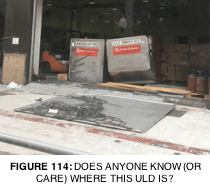ULD Management & Control
What does it take to manage a fleet of ULD?
The short answer to this question is: a lot of hard work, backed up by ample experience. For all airlines, operating wide-body aircraft ULD is an essential part of day-to-day operations, so ensuring that every flight has sufficient amounts of the right types of ULD at the right place at the right time is critical. Given the commercial importance of this function, one would imagine it would receive a certain degree of status within airline operations, but regrettably, ULD control and management is often low in the ranks. This vital function only comes into the spotlight when, for one reason or another, a ULD situation impacts on company operations.
ULD control and management challenges
The biggest issue for any ULD control team is probably the matter of imbalances. One major imbalance that impacts all airlines is the preference for flights originating from certain locations to use a majority of pallets or a majority of containers, while return flights have an opposite preference. This can be due to cargo types or shipper preferences, but, regardless of the reason, it can result in a major overstock of one type of ULD at one location, and an understock of a different type at another location.
Another issue is that the ability of aircraft to carry cargo is impacted by prevailing winds in certain areas. For example, in the northern winter, jet streams blows strongly from west to east, so flights going from Asia to the USA can carry plenty of cargo, while flights returning may take 2-3 hours longer. As such, their load is weight restricted, meaning that some ULD that went to the USA cannot be carried back. Very long flights are especially afflicted by this issue.
Charters to remote airports are also often a source of trouble. The plane, typically a large freighter, lands at a remote location, unloads its cargo, and then quickly departs, leaving behind sometimes more than forty PMC pallets. To counteract load weight and time issues, airlines have asked ULD designers to create a collapsible container for years now, one that can be loaded with cargo in one direction and then return as a flat pack. While this idea has much potential in theory, it has never been realised on a large scale due to the difficulty in arranging for units to be correctly collapsed and packed for transport, and then unpacked and reassembled before re-use. Add into this equation unique positioning needs for special purpose ULD such as temperature controlled containers or horse stalls, and it becomes clear that a typical ULD controller has quite a stressful job.
If the challenges listed above are not enough, their job is made harder by the fact that they often do not receive accurate and timely information about stock and transfer of ULD. ULD controllers rely on the accuracy of data contained in computer systems to properly carry out their jobs, but all too often, data can be mismatched to actual stock levels or locations. Problems generally arise when ULD are transferred to a third, fourth, or even fifth party at a remote station, and that information is not reported back to the ULD control centre. This situation is made worse if accurate and timely stock control checks are not carried out on an agreed schedule, with data regularly reported back to ULD controllers.
Tracking the location of ULD
 For the past thirty years, ongoing efforts have been made to create an automated tracking system for ULD. There has been some limited success, but widespread adoption of any such system remains out of sight. The main reasons for this lack of progress are financial and technical obstacles, and while it would be wrong to rule out the possibility of any such system becoming widely used, the lack of progress over the past thirty years does not offer much optimism. IATA continues to work on industry standards, and technology may give rise to new practical and economic possibilities. In the meantime, however, ULD controllers are forced to rely on transmitted messages and stock reports to locate their assets.
For the past thirty years, ongoing efforts have been made to create an automated tracking system for ULD. There has been some limited success, but widespread adoption of any such system remains out of sight. The main reasons for this lack of progress are financial and technical obstacles, and while it would be wrong to rule out the possibility of any such system becoming widely used, the lack of progress over the past thirty years does not offer much optimism. IATA continues to work on industry standards, and technology may give rise to new practical and economic possibilities. In the meantime, however, ULD controllers are forced to rely on transmitted messages and stock reports to locate their assets.
Barcoding systems for ULD fall somewhere in the middle of no tracking system at all and lofty ambitions of RFID tracking or similar. It is relatively easy to attach a barcode to a container, and quite practical to add a barcode sticker to the inside of a pallet seat track. IATA standards for adding barcodes are contained in Section 7 of the ULDR. Having a barcode certainly improves the accuracy of recording a ULD’s IATA code details, and given that modern smartphones generally having the capability to read a barcode, this offers a practical and cost-effective alternative to RFID.
ULD management systems
There are two critical components of ULD management, the first being the need to keep track of any movement of ULD from one party to another, and the second being the need for reliable and timely stock control reporting. The below systems are designed to facilitate the achievement of such objectives.
ULD Control Message (UCM)
The UCM has been around for many years. Established as an IATA standard, the UCM is the backbone of ULD messaging, and with accurate and timely implementation, a UCM can provide ULD control managers with all the necessary information. However, if this requirement is not carried out or is carried out inaccurately, then a ULD controller will be completely unaware of the location of their ULD. An example of a UCM is shown below:
UCM
CX893/12.HKG
IN
AKE12642.AKE12384.AKE12866.AKE12878.AKE12381.AKE12993.AKE01125JL
OUT
.AKE14101/KHI.AKE11401/KHI.AKE84103LH/BKK
Stock Check Message (SCM)
The ULD SCM provides confirmation to ULD controllers of the inventory of their ULD in any particular location, at any particular point in time. As with a UCM, an SCM follows a defined IATA standard, and, when transmitted in an accurate and timely manner, effectively keeps a ULD controller informed of the ULD stock they hold at any location. An example of a SCM is shown below:
SCM
HKG.23DEC/1230
.AKE.40289BA/40846BA/41873BA/72772AA.T4
.RKN.03281BA/04883BA/08022BA/07984BA.T4
.AAP.03349SR.T1
.UAK.07826BA/08287BA/10748BA/60709TE.T4
.PAG.77821BA/70811BA/02422SK.T3
SI NETS BA TWO/SK ONE
Provided that UCMs and SCMs are used continuously and accurately, the job of a ULD controller is made relatively easy. Although their ULD may not be exactly where they should be, at least they can be located!



